Dissertation: Significance of Employee Training to Raise Asda's Profit
VerifiedAdded on 2023/06/12
|6
|1352
|404
Thesis and Dissertation
AI Summary
This dissertation investigates the significance of employee training in enhancing organizational profit, focusing on Asda, a major UK retail brand. It begins by outlining the importance of employee training programs in improving employee knowledge, skills, and motivation, leading to increased productivity and reduced costs. The research explores how training contributes to employee development, job satisfaction, and the overall efficiency of the organization. It also examines Asda's background, objectives, and beliefs, highlighting its focus on low-cost, high-quality goods and services. The rationale for the research is to demonstrate the positive changes and benefits that training and development programs can bring to a company, including increased profitability. The dissertation aims to determine the significance of employee training in raising organizational profit, with specific objectives to understand the meaning of employee training, analyze its importance in increasing organizational profit, and examine the challenges faced when eliminating employee training. Key research questions address the concept of employee training, its importance in enhancing company profits, and the challenges faced when training is absent.
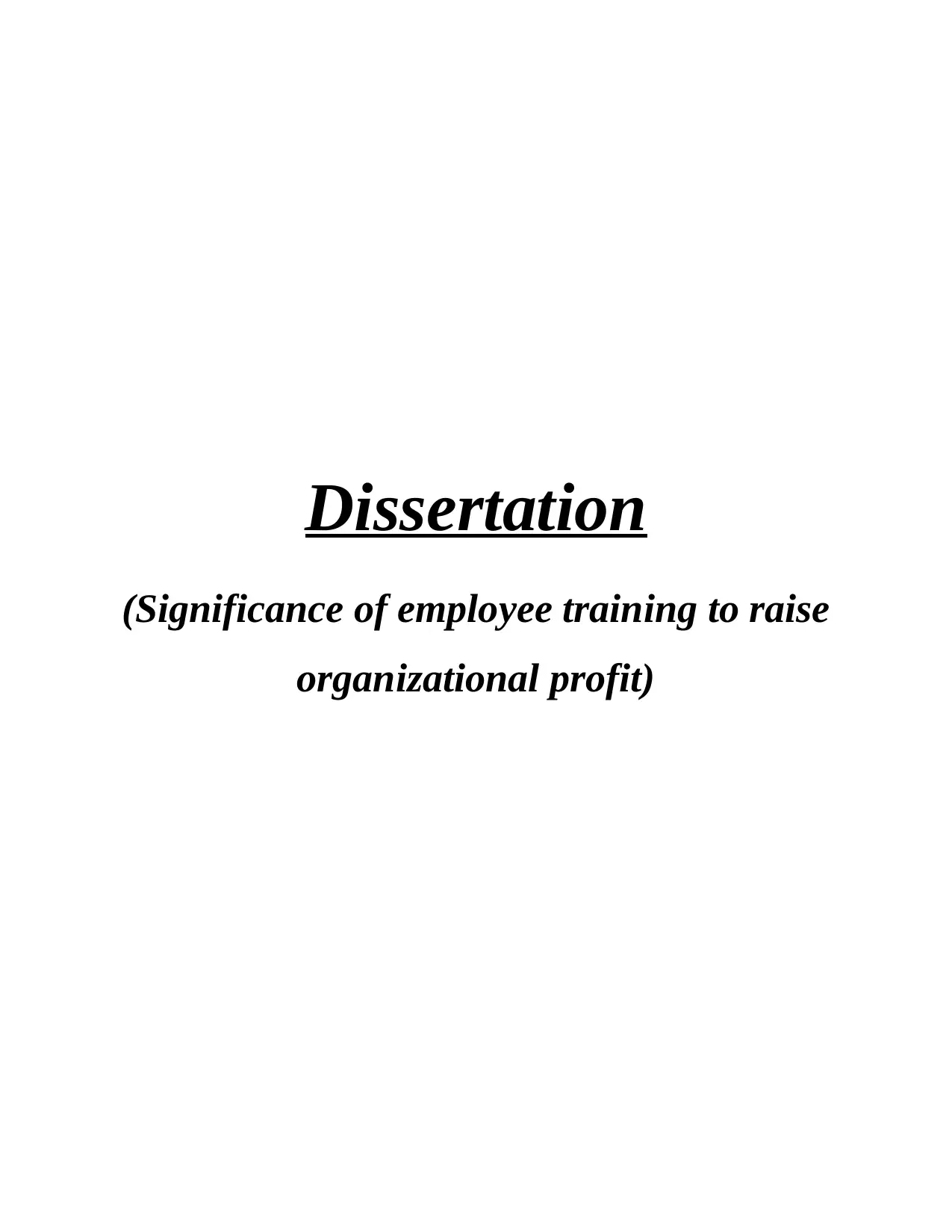
Dissertation
(Significance of employee training to raise
organizational profit)
(Significance of employee training to raise
organizational profit)
Paraphrase This Document
Need a fresh take? Get an instant paraphrase of this document with our AI Paraphraser
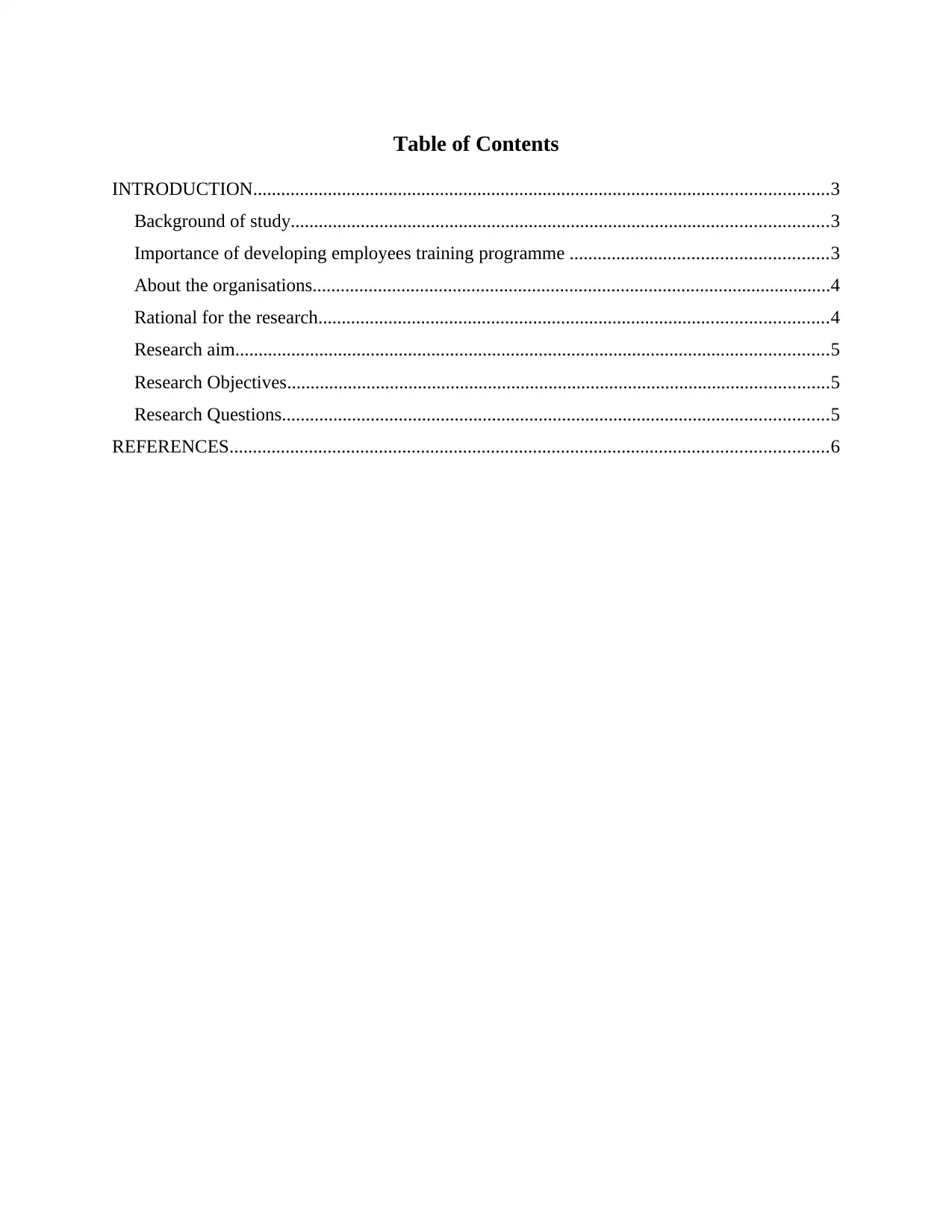
Table of Contents
INTRODUCTION...........................................................................................................................3
Background of study...................................................................................................................3
Importance of developing employees training programme .......................................................3
About the organisations...............................................................................................................4
Rational for the research.............................................................................................................4
Research aim...............................................................................................................................5
Research Objectives....................................................................................................................5
Research Questions.....................................................................................................................5
REFERENCES................................................................................................................................6
INTRODUCTION...........................................................................................................................3
Background of study...................................................................................................................3
Importance of developing employees training programme .......................................................3
About the organisations...............................................................................................................4
Rational for the research.............................................................................................................4
Research aim...............................................................................................................................5
Research Objectives....................................................................................................................5
Research Questions.....................................................................................................................5
REFERENCES................................................................................................................................6
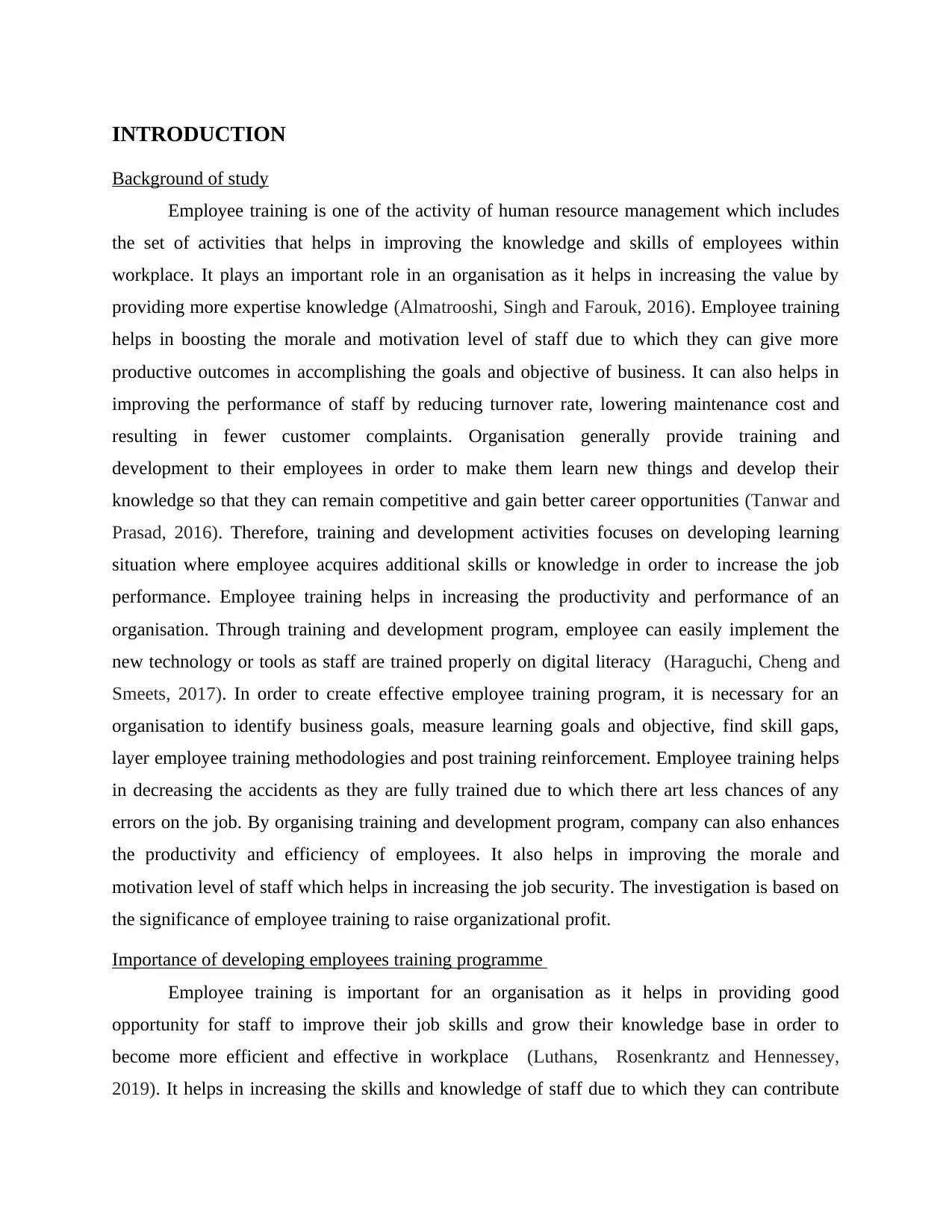
INTRODUCTION
Background of study
Employee training is one of the activity of human resource management which includes
the set of activities that helps in improving the knowledge and skills of employees within
workplace. It plays an important role in an organisation as it helps in increasing the value by
providing more expertise knowledge (Almatrooshi, Singh and Farouk, 2016). Employee training
helps in boosting the morale and motivation level of staff due to which they can give more
productive outcomes in accomplishing the goals and objective of business. It can also helps in
improving the performance of staff by reducing turnover rate, lowering maintenance cost and
resulting in fewer customer complaints. Organisation generally provide training and
development to their employees in order to make them learn new things and develop their
knowledge so that they can remain competitive and gain better career opportunities (Tanwar and
Prasad, 2016). Therefore, training and development activities focuses on developing learning
situation where employee acquires additional skills or knowledge in order to increase the job
performance. Employee training helps in increasing the productivity and performance of an
organisation. Through training and development program, employee can easily implement the
new technology or tools as staff are trained properly on digital literacy (Haraguchi, Cheng and
Smeets, 2017). In order to create effective employee training program, it is necessary for an
organisation to identify business goals, measure learning goals and objective, find skill gaps,
layer employee training methodologies and post training reinforcement. Employee training helps
in decreasing the accidents as they are fully trained due to which there art less chances of any
errors on the job. By organising training and development program, company can also enhances
the productivity and efficiency of employees. It also helps in improving the morale and
motivation level of staff which helps in increasing the job security. The investigation is based on
the significance of employee training to raise organizational profit.
Importance of developing employees training programme
Employee training is important for an organisation as it helps in providing good
opportunity for staff to improve their job skills and grow their knowledge base in order to
become more efficient and effective in workplace (Luthans, Rosenkrantz and Hennessey,
2019). It helps in increasing the skills and knowledge of staff due to which they can contribute
Background of study
Employee training is one of the activity of human resource management which includes
the set of activities that helps in improving the knowledge and skills of employees within
workplace. It plays an important role in an organisation as it helps in increasing the value by
providing more expertise knowledge (Almatrooshi, Singh and Farouk, 2016). Employee training
helps in boosting the morale and motivation level of staff due to which they can give more
productive outcomes in accomplishing the goals and objective of business. It can also helps in
improving the performance of staff by reducing turnover rate, lowering maintenance cost and
resulting in fewer customer complaints. Organisation generally provide training and
development to their employees in order to make them learn new things and develop their
knowledge so that they can remain competitive and gain better career opportunities (Tanwar and
Prasad, 2016). Therefore, training and development activities focuses on developing learning
situation where employee acquires additional skills or knowledge in order to increase the job
performance. Employee training helps in increasing the productivity and performance of an
organisation. Through training and development program, employee can easily implement the
new technology or tools as staff are trained properly on digital literacy (Haraguchi, Cheng and
Smeets, 2017). In order to create effective employee training program, it is necessary for an
organisation to identify business goals, measure learning goals and objective, find skill gaps,
layer employee training methodologies and post training reinforcement. Employee training helps
in decreasing the accidents as they are fully trained due to which there art less chances of any
errors on the job. By organising training and development program, company can also enhances
the productivity and efficiency of employees. It also helps in improving the morale and
motivation level of staff which helps in increasing the job security. The investigation is based on
the significance of employee training to raise organizational profit.
Importance of developing employees training programme
Employee training is important for an organisation as it helps in providing good
opportunity for staff to improve their job skills and grow their knowledge base in order to
become more efficient and effective in workplace (Luthans, Rosenkrantz and Hennessey,
2019). It helps in increasing the skills and knowledge of staff due to which they can contribute
⊘ This is a preview!⊘
Do you want full access?
Subscribe today to unlock all pages.

Trusted by 1+ million students worldwide
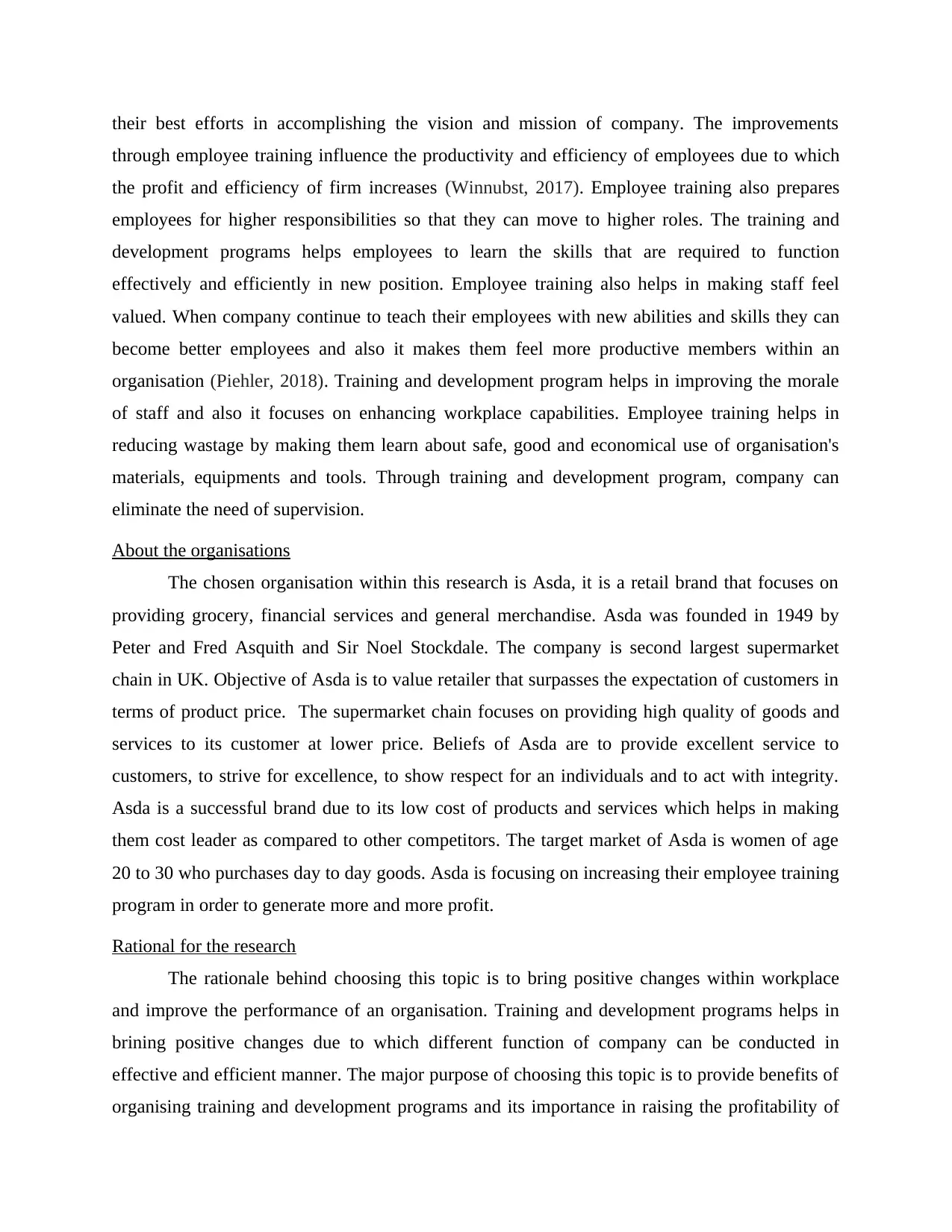
their best efforts in accomplishing the vision and mission of company. The improvements
through employee training influence the productivity and efficiency of employees due to which
the profit and efficiency of firm increases (Winnubst, 2017). Employee training also prepares
employees for higher responsibilities so that they can move to higher roles. The training and
development programs helps employees to learn the skills that are required to function
effectively and efficiently in new position. Employee training also helps in making staff feel
valued. When company continue to teach their employees with new abilities and skills they can
become better employees and also it makes them feel more productive members within an
organisation (Piehler, 2018). Training and development program helps in improving the morale
of staff and also it focuses on enhancing workplace capabilities. Employee training helps in
reducing wastage by making them learn about safe, good and economical use of organisation's
materials, equipments and tools. Through training and development program, company can
eliminate the need of supervision.
About the organisations
The chosen organisation within this research is Asda, it is a retail brand that focuses on
providing grocery, financial services and general merchandise. Asda was founded in 1949 by
Peter and Fred Asquith and Sir Noel Stockdale. The company is second largest supermarket
chain in UK. Objective of Asda is to value retailer that surpasses the expectation of customers in
terms of product price. The supermarket chain focuses on providing high quality of goods and
services to its customer at lower price. Beliefs of Asda are to provide excellent service to
customers, to strive for excellence, to show respect for an individuals and to act with integrity.
Asda is a successful brand due to its low cost of products and services which helps in making
them cost leader as compared to other competitors. The target market of Asda is women of age
20 to 30 who purchases day to day goods. Asda is focusing on increasing their employee training
program in order to generate more and more profit.
Rational for the research
The rationale behind choosing this topic is to bring positive changes within workplace
and improve the performance of an organisation. Training and development programs helps in
brining positive changes due to which different function of company can be conducted in
effective and efficient manner. The major purpose of choosing this topic is to provide benefits of
organising training and development programs and its importance in raising the profitability of
through employee training influence the productivity and efficiency of employees due to which
the profit and efficiency of firm increases (Winnubst, 2017). Employee training also prepares
employees for higher responsibilities so that they can move to higher roles. The training and
development programs helps employees to learn the skills that are required to function
effectively and efficiently in new position. Employee training also helps in making staff feel
valued. When company continue to teach their employees with new abilities and skills they can
become better employees and also it makes them feel more productive members within an
organisation (Piehler, 2018). Training and development program helps in improving the morale
of staff and also it focuses on enhancing workplace capabilities. Employee training helps in
reducing wastage by making them learn about safe, good and economical use of organisation's
materials, equipments and tools. Through training and development program, company can
eliminate the need of supervision.
About the organisations
The chosen organisation within this research is Asda, it is a retail brand that focuses on
providing grocery, financial services and general merchandise. Asda was founded in 1949 by
Peter and Fred Asquith and Sir Noel Stockdale. The company is second largest supermarket
chain in UK. Objective of Asda is to value retailer that surpasses the expectation of customers in
terms of product price. The supermarket chain focuses on providing high quality of goods and
services to its customer at lower price. Beliefs of Asda are to provide excellent service to
customers, to strive for excellence, to show respect for an individuals and to act with integrity.
Asda is a successful brand due to its low cost of products and services which helps in making
them cost leader as compared to other competitors. The target market of Asda is women of age
20 to 30 who purchases day to day goods. Asda is focusing on increasing their employee training
program in order to generate more and more profit.
Rational for the research
The rationale behind choosing this topic is to bring positive changes within workplace
and improve the performance of an organisation. Training and development programs helps in
brining positive changes due to which different function of company can be conducted in
effective and efficient manner. The major purpose of choosing this topic is to provide benefits of
organising training and development programs and its importance in raising the profitability of
Paraphrase This Document
Need a fresh take? Get an instant paraphrase of this document with our AI Paraphraser
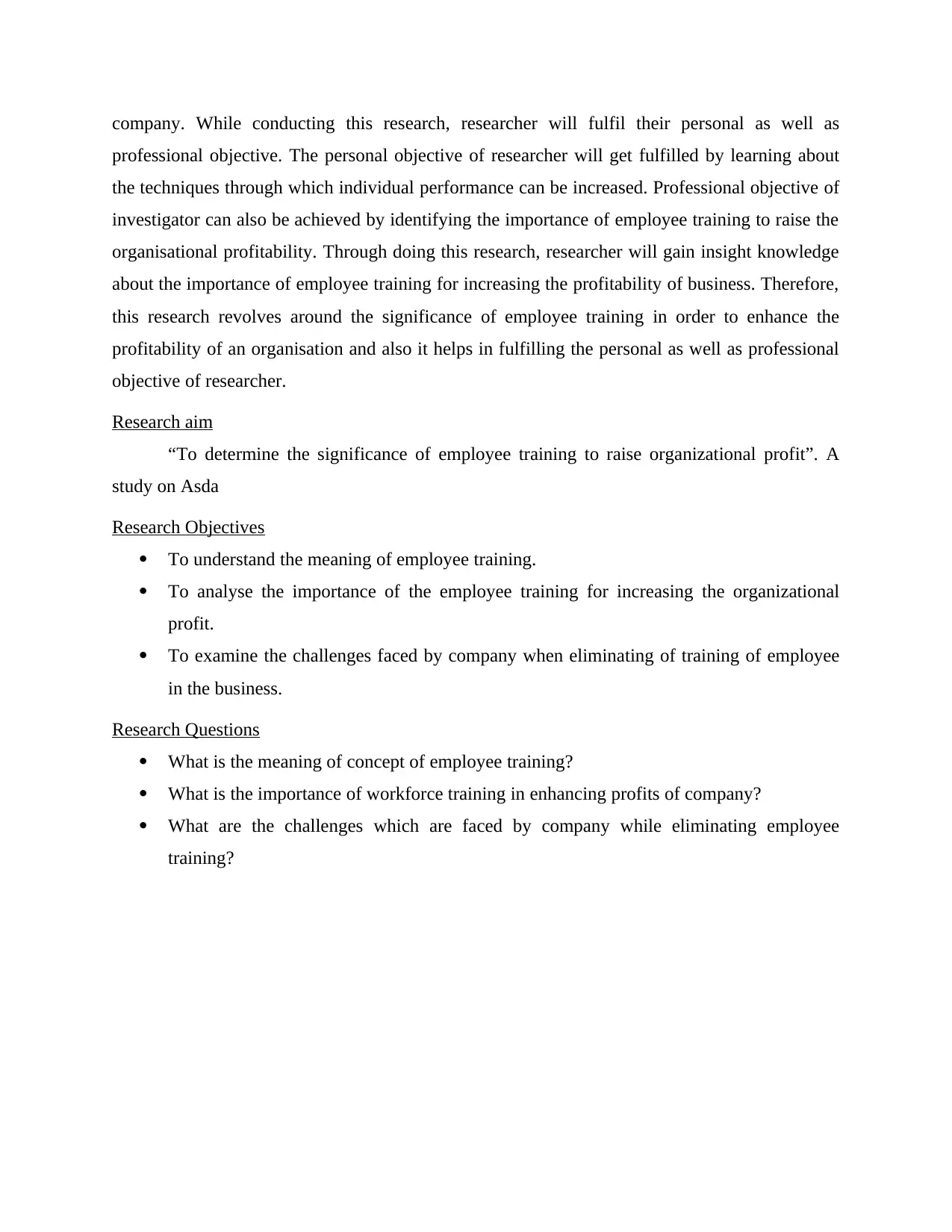
company. While conducting this research, researcher will fulfil their personal as well as
professional objective. The personal objective of researcher will get fulfilled by learning about
the techniques through which individual performance can be increased. Professional objective of
investigator can also be achieved by identifying the importance of employee training to raise the
organisational profitability. Through doing this research, researcher will gain insight knowledge
about the importance of employee training for increasing the profitability of business. Therefore,
this research revolves around the significance of employee training in order to enhance the
profitability of an organisation and also it helps in fulfilling the personal as well as professional
objective of researcher.
Research aim
“To determine the significance of employee training to raise organizational profit”. A
study on Asda
Research Objectives
To understand the meaning of employee training.
To analyse the importance of the employee training for increasing the organizational
profit.
To examine the challenges faced by company when eliminating of training of employee
in the business.
Research Questions
What is the meaning of concept of employee training?
What is the importance of workforce training in enhancing profits of company?
What are the challenges which are faced by company while eliminating employee
training?
professional objective. The personal objective of researcher will get fulfilled by learning about
the techniques through which individual performance can be increased. Professional objective of
investigator can also be achieved by identifying the importance of employee training to raise the
organisational profitability. Through doing this research, researcher will gain insight knowledge
about the importance of employee training for increasing the profitability of business. Therefore,
this research revolves around the significance of employee training in order to enhance the
profitability of an organisation and also it helps in fulfilling the personal as well as professional
objective of researcher.
Research aim
“To determine the significance of employee training to raise organizational profit”. A
study on Asda
Research Objectives
To understand the meaning of employee training.
To analyse the importance of the employee training for increasing the organizational
profit.
To examine the challenges faced by company when eliminating of training of employee
in the business.
Research Questions
What is the meaning of concept of employee training?
What is the importance of workforce training in enhancing profits of company?
What are the challenges which are faced by company while eliminating employee
training?

REFERENCES
Books and Journals
Almatrooshi, B., Singh, S. K. and Farouk, S., 2016. Determinants of organizational performance:
a proposed framework. International Journal of productivity and performance
management.
Haraguchi, N., Cheng, C. F. C. and Smeets, E., 2017. The importance of manufacturing in
economic development: has this changed?. World Development, 93, pp.293-315.
Luthans, F., Rosenkrantz, S. A. and Hennessey, H. W., 2019. What do successful managers
really do? An observation study of managerial activities. In Managerial Work (pp. 165-
180). Routledge.
Piehler, R., 2018. Employees’ brand understanding, brand commitment, and brand citizenship
behaviour: a closer look at the relationships among construct dimensions. Journal of
brand management, 25(3), pp.217-234.
Tanwar, K. and Prasad, A., 2016. Exploring the relationship between employer branding and
employee retention. Global business review, 17(3_suppl), pp.186S-206S.
Winnubst, J., 2017. Organizational structure, social support, and burnout. In Professional
burnout (pp. 151-162). Routledge.
Books and Journals
Almatrooshi, B., Singh, S. K. and Farouk, S., 2016. Determinants of organizational performance:
a proposed framework. International Journal of productivity and performance
management.
Haraguchi, N., Cheng, C. F. C. and Smeets, E., 2017. The importance of manufacturing in
economic development: has this changed?. World Development, 93, pp.293-315.
Luthans, F., Rosenkrantz, S. A. and Hennessey, H. W., 2019. What do successful managers
really do? An observation study of managerial activities. In Managerial Work (pp. 165-
180). Routledge.
Piehler, R., 2018. Employees’ brand understanding, brand commitment, and brand citizenship
behaviour: a closer look at the relationships among construct dimensions. Journal of
brand management, 25(3), pp.217-234.
Tanwar, K. and Prasad, A., 2016. Exploring the relationship between employer branding and
employee retention. Global business review, 17(3_suppl), pp.186S-206S.
Winnubst, J., 2017. Organizational structure, social support, and burnout. In Professional
burnout (pp. 151-162). Routledge.
⊘ This is a preview!⊘
Do you want full access?
Subscribe today to unlock all pages.

Trusted by 1+ million students worldwide
1 out of 6
Related Documents
Your All-in-One AI-Powered Toolkit for Academic Success.
+13062052269
info@desklib.com
Available 24*7 on WhatsApp / Email
![[object Object]](/_next/static/media/star-bottom.7253800d.svg)
Unlock your academic potential
Copyright © 2020–2025 A2Z Services. All Rights Reserved. Developed and managed by ZUCOL.





